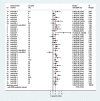Multivariate meta-analysis of prognostic factor studies with multiple cut-points and/or methods of measurement
- PMID: 25924725
- PMCID: PMC4973834
- DOI: 10.1002/sim.6493
Multivariate meta-analysis of prognostic factor studies with multiple cut-points and/or methods of measurement
Abstract
A prognostic factor is any measure that is associated with the risk of future health outcomes in those with existing disease. Often, the prognostic ability of a factor is evaluated in multiple studies. However, meta-analysis is difficult because primary studies often use different methods of measurement and/or different cut-points to dichotomise continuous factors into 'high' and 'low' groups; selective reporting is also common. We illustrate how multivariate random effects meta-analysis models can accommodate multiple prognostic effect estimates from the same study, relating to multiple cut-points and/or methods of measurement. The models account for within-study and between-study correlations, which utilises more information and reduces the impact of unreported cut-points and/or measurement methods in some studies. The applicability of the approach is improved with individual participant data and by assuming a functional relationship between prognostic effect and cut-point to reduce the number of unknown parameters. The models provide important inferential results for each cut-point and method of measurement, including the summary prognostic effect, the between-study variance and a 95% prediction interval for the prognostic effect in new populations. Two applications are presented. The first reveals that, in a multivariate meta-analysis using published results, the Apgar score is prognostic of neonatal mortality but effect sizes are smaller at most cut-points than previously thought. In the second, a multivariate meta-analysis of two methods of measurement provides weak evidence that microvessel density is prognostic of mortality in lung cancer, even when individual participant data are available so that a continuous prognostic trend is examined (rather than cut-points).
Keywords: cut-points; heterogeneity; multivariate meta-analysis; odds ratios and hazard ratios; prognostic factors.
© 2015 The Authors. Statistics in Medicine Published by John Wiley & Sons Ltd.
Figures


References
-
- Armitage P, Gehan EA. Statistical methods for the identification and use of prognostic factors. International Journal of Cancer 1974; 13:16–36. - PubMed
-
- Altman DG, Riley RD. An evidence‐based approach to prognostic markers. Nature Clinical Practice Oncology 2005; 2:466–472. - PubMed
-
- Riley RD, Ridley G, Williams K, Altman DG, Hayden J, de Vet HC. Prognosis research: toward evidence‐based results and a Cochrane methods group. Journal of Clinical Epidemiology 2007; 60:863–865. author reply 865‐866. - PubMed
Publication types
MeSH terms
Substances
Grants and funding
LinkOut - more resources
Full Text Sources
Other Literature Sources

